Vector data manipulation¶
Example SpatialPolygons
f <- system.file("external/lux.shp", package="raster")
library(raster)
p <- shapefile(f)
p
## class : SpatialPolygonsDataFrame
## features : 12
## extent : 5.74414, 6.528252, 49.44781, 50.18162 (xmin, xmax, ymin, ymax)
## crs : +proj=longlat +datum=WGS84 +no_defs
## variables : 5
## names : ID_1, NAME_1, ID_2, NAME_2, AREA
## min values : 1, Diekirch, 1, Capellen, 76
## max values : 3, Luxembourg, 12, Wiltz, 312
par(mai=c(0,0,0,0))
plot(p)
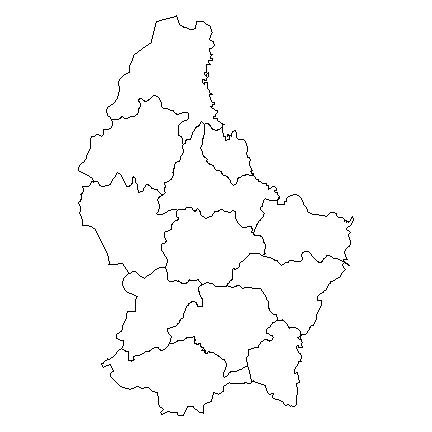
Basics¶
Basic operations are pretty much like working with a data.frame.
Geometry and attributes¶
To extract the attributes (data.frame) from a Spatial object, use:
d <- data.frame(p)
head(d)
## ID_1 NAME_1 ID_2 NAME_2 AREA
## 0 1 Diekirch 1 Clervaux 312
## 1 1 Diekirch 2 Diekirch 218
## 2 1 Diekirch 3 Redange 259
## 3 1 Diekirch 4 Vianden 76
## 4 1 Diekirch 5 Wiltz 263
## 5 2 Grevenmacher 6 Echternach 188
Extracting geometry (rarely needed).
g <- geom(p)
head(g)
## object part cump hole x y
## [1,] 1 1 1 0 6.026519 50.17767
## [2,] 1 1 1 0 6.031361 50.16563
## [3,] 1 1 1 0 6.035646 50.16410
## [4,] 1 1 1 0 6.042747 50.16157
## [5,] 1 1 1 0 6.043894 50.16116
## [6,] 1 1 1 0 6.048243 50.16008
Variables¶
Extracting a variable.
p$NAME_2
## [1] "Clervaux" "Diekirch" "Redange" "Vianden"
## [5] "Wiltz" "Echternach" "Remich" "Grevenmacher"
## [9] "Capellen" "Esch-sur-Alzette" "Luxembourg" "Mersch"
Sub-setting by variable. Note how this is different from the above example. Above a vector of values is returned. With the approach below you get a new SpatialPolygonsDataFrame with only one variable.
p[, 'NAME_2']
## class : SpatialPolygonsDataFrame
## features : 12
## extent : 5.74414, 6.528252, 49.44781, 50.18162 (xmin, xmax, ymin, ymax)
## crs : +proj=longlat +datum=WGS84 +no_defs
## variables : 1
## names : NAME_2
## min values : Capellen
## max values : Wiltz
Adding a new variable.
set.seed(0)
p$new <- sample(letters, length(p))
p
## class : SpatialPolygonsDataFrame
## features : 12
## extent : 5.74414, 6.528252, 49.44781, 50.18162 (xmin, xmax, ymin, ymax)
## crs : +proj=longlat +datum=WGS84 +no_defs
## variables : 6
## names : ID_1, NAME_1, ID_2, NAME_2, AREA, new
## min values : 1, Diekirch, 1, Capellen, 76, a
## max values : 3, Luxembourg, 12, Wiltz, 312, z
Assigning a new value to an existing variable.
p$new <- sample(LETTERS, length(p))
p
## class : SpatialPolygonsDataFrame
## features : 12
## extent : 5.74414, 6.528252, 49.44781, 50.18162 (xmin, xmax, ymin, ymax)
## crs : +proj=longlat +datum=WGS84 +no_defs
## variables : 6
## names : ID_1, NAME_1, ID_2, NAME_2, AREA, new
## min values : 1, Diekirch, 1, Capellen, 76, E
## max values : 3, Luxembourg, 12, Wiltz, 312, Z
To get rid of a variable.
p$new <- NULL
Merge¶
You can join a table (data.frame) with a Spatial* object with
merge.
dfr <- data.frame(District=p$NAME_1, Canton=p$NAME_2, Value=round(runif(length(p), 100, 1000)))
dfr <- dfr[order(dfr$Canton), ]
pm <- merge(p, dfr, by.x=c('NAME_1', 'NAME_2'), by.y=c('District', 'Canton'))
pm
## class : SpatialPolygonsDataFrame
## features : 12
## extent : 5.74414, 6.528252, 49.44781, 50.18162 (xmin, xmax, ymin, ymax)
## crs : +proj=longlat +datum=WGS84 +no_defs
## variables : 6
## names : NAME_1, NAME_2, ID_1, ID_2, AREA, Value
## min values : Diekirch, Capellen, 1, 1, 76, 197
## max values : Luxembourg, Wiltz, 3, 12, 312, 845
Records¶
Selecting rows (records).
i <- which(p$NAME_1 == 'Grevenmacher')
g <- p[i,]
g
## class : SpatialPolygonsDataFrame
## features : 3
## extent : 6.169137, 6.528252, 49.46498, 49.85403 (xmin, xmax, ymin, ymax)
## crs : +proj=longlat +datum=WGS84 +no_defs
## variables : 5
## names : ID_1, NAME_1, ID_2, NAME_2, AREA
## min values : 2, Grevenmacher, 6, Echternach, 129
## max values : 2, Grevenmacher, 12, Remich, 210
It is also possible to interactively select and query records by
clicking on a plotted dataset. That is difficult to show here. See
?select for interactively selecting spatial features and ?click
to identify attributes by clicking on a plot (map).
Append and aggregate¶
Append¶
More example data. Object z, consisting of four polygons, and z2
which is one of these four polygons.
z <- raster(p, nrow=2, ncol=2, vals=1:4)
names(z) <- 'Zone'
# coerce RasterLayer to SpatialPolygonsDataFrame
z <- as(z, 'SpatialPolygonsDataFrame')
z
## class : SpatialPolygonsDataFrame
## features : 4
## extent : 5.74414, 6.528252, 49.44781, 50.18162 (xmin, xmax, ymin, ymax)
## crs : +proj=longlat +datum=WGS84 +no_defs
## variables : 1
## names : Zone
## min values : 1
## max values : 4
z2 <- z[2,]
plot(p)
plot(z, add=TRUE, border='blue', lwd=5)
plot(z2, add=TRUE, border='red', lwd=2, density=3, col='red')

To append Spatial* objects of the same (vector) type you can use
bind
b <- bind(p, z)
head(b)
## ID_1 NAME_1 ID_2 NAME_2 AREA Zone
## 1 1 Diekirch 1 Clervaux 312 NA
## 2 1 Diekirch 2 Diekirch 218 NA
## 3 1 Diekirch 3 Redange 259 NA
## 4 1 Diekirch 4 Vianden 76 NA
## 5 1 Diekirch 5 Wiltz 263 NA
## 6 2 Grevenmacher 6 Echternach 188 NA
tail(b)
## ID_1 NAME_1 ID_2 NAME_2 AREA Zone
## 11 3 Luxembourg 10 Luxembourg 237 NA
## 12 3 Luxembourg 11 Mersch 233 NA
## 13 NA <NA> NA <NA> NA 1
## 14 NA <NA> NA <NA> NA 2
## 15 NA <NA> NA <NA> NA 3
## 16 NA <NA> NA <NA> NA 4
Note how bind allows you to append Spatial* objects with
different attribute names.
Aggregate¶
pa <- aggregate(p, by='NAME_1')
za <- aggregate(z)
plot(za, col='light gray', border='light gray', lwd=5)
plot(pa, add=TRUE, col=rainbow(3), lwd=3, border='white')
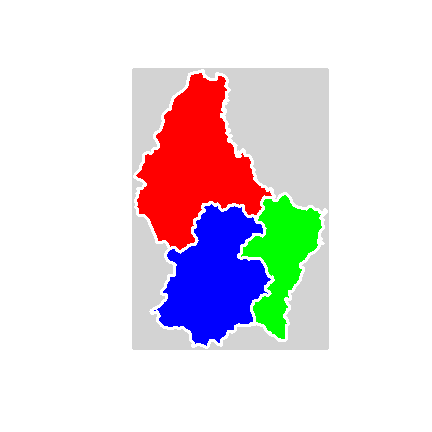
You can also aggregate by providing a second Spatial object (see
?sp::aggregate)
Aggregate without dissolve
zag <- aggregate(z, dissolve=FALSE)
zag
## class : SpatialPolygons
## features : 1
## extent : 5.74414, 6.528252, 49.44781, 50.18162 (xmin, xmax, ymin, ymax)
## crs : +proj=longlat +datum=WGS84 +no_defs
plot(zag, col="light gray")
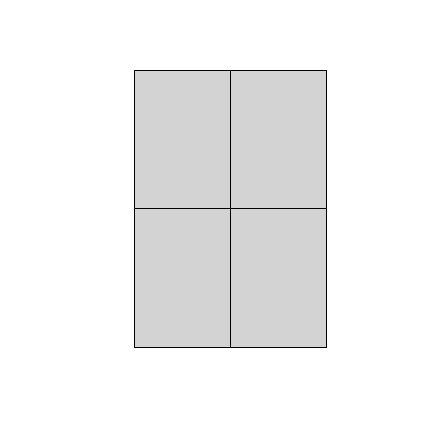
This is a structure that is similar to what you may get for an
archipelago: multiple polygons represented as one entity (one row). Use
disaggregate to split these up into their parts.
zd <- disaggregate(zag)
zd
## class : SpatialPolygons
## features : 4
## extent : 5.74414, 6.528252, 49.44781, 50.18162 (xmin, xmax, ymin, ymax)
## crs : +proj=longlat +datum=WGS84 +no_defs
Overlay¶
Erase¶
Erase a part of a SpatialPolygons object
e <- erase(p, z2)
This is equivalent to
e <- p - z2
plot(e)
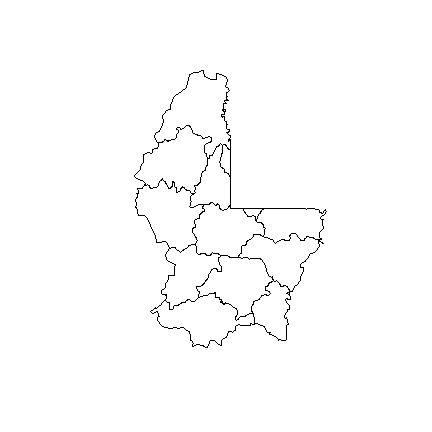
Intersect¶
Intersect SpatialPolygons
i <- intersect(p, z2)
plot(i)
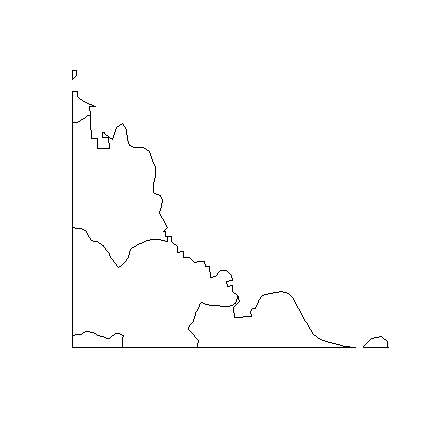
This is equivalent to
i <- p * z2
You can also intersect with an Extent (rectangle).
e <- extent(6, 6.4, 49.7, 50)
pe <- crop(p, e)
plot(p)
plot(pe, col='light blue', add=TRUE)
plot(e, add=TRUE, lwd=3, col='red')
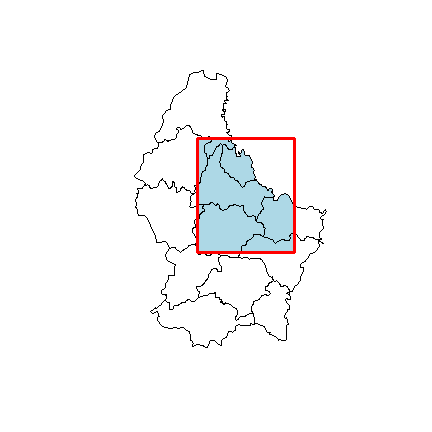
Union¶
Get the union of two SpatialPolygon* objects.
u <- union(p, z)
This is equivalent to
u <- p + z
Note that there are many more polygons now. One for each unique combination of polygons (and attributes in this case).
u
## class : SpatialPolygonsDataFrame
## features : 28
## extent : 5.74414, 6.528252, 49.44781, 50.18162 (xmin, xmax, ymin, ymax)
## crs : +proj=longlat +datum=WGS84 +no_defs
## variables : 6
## names : Zone, ID_1, NAME_1, ID_2, NAME_2, AREA
## min values : 1, 1, Diekirch, 1, Capellen, 76
## max values : 4, 3, Luxembourg, 12, Wiltz, 312
set.seed(5)
plot(u, col=sample(rainbow(length(u))))

Cover¶
Cover is a combination of intersect and union
cov <- cover(p, z)
cov
## class : SpatialPolygonsDataFrame
## features : 6
## extent : 5.74414, 6.528252, 49.44781, 50.18162 (xmin, xmax, ymin, ymax)
## crs : +proj=longlat +datum=WGS84 +no_defs
## variables : 6
## names : ID_1, NAME_1, ID_2, NAME_2, AREA, Zone
## min values : 1, Diekirch, 1, Clervaux, 188, 1
## max values : 2, Grevenmacher, 6, Echternach, 312, 4
plot(cov)
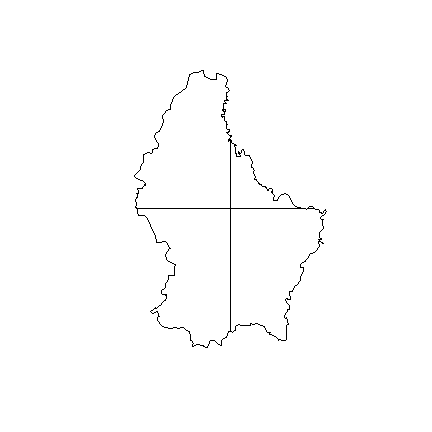
Difference¶
The symmetrical difference of two SpatialPolygons* objects
dif <- symdif(z,p)
plot(dif, col=rainbow(length(dif)))
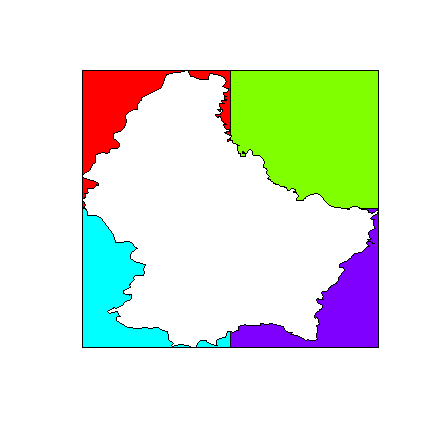
dif
## class : SpatialPolygonsDataFrame
## features : 4
## extent : 5.74414, 6.528252, 49.44781, 50.18162 (xmin, xmax, ymin, ymax)
## crs : NA
## variables : 1
## names : Zone
## min values : 1
## max values : 4
Spatial queries¶
Query polygons with points.
pts <- matrix(c(6, 6.1, 5.9, 5.7, 6.4, 50, 49.9, 49.8, 49.7, 49.5), ncol=2)
spts <- SpatialPoints(pts, proj4string=crs(p))
plot(z, col='light blue', lwd=2)
points(spts, col='light gray', pch=20, cex=6)
text(spts, 1:nrow(pts), col='red', font=2, cex=1.5)
lines(p, col='blue', lwd=2)
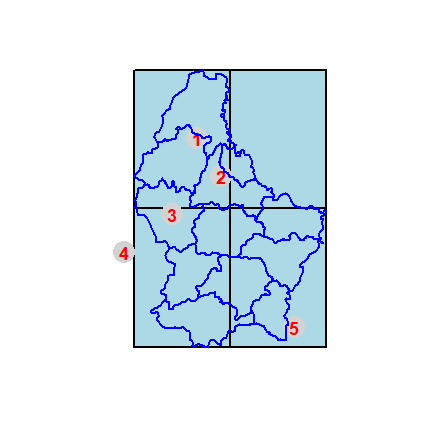
Use over for queries between Spatial* objects
over(spts, p)
## ID_1 NAME_1 ID_2 NAME_2 AREA
## 1 1 Diekirch 5 Wiltz 263
## 2 1 Diekirch 2 Diekirch 218
## 3 1 Diekirch 3 Redange 259
## 4 NA <NA> NA <NA> NA
## 5 NA <NA> NA <NA> NA
over(spts, z)
## Zone
## 1 1
## 2 1
## 3 3
## 4 NA
## 5 4
extract is generally used for queries between Spatial* and Raster*
objects, but it can also be used here.
extract(z, pts)
## point.ID poly.ID Zone
## 1 1 1 1
## 2 2 1 1
## 3 3 3 3
## 4 4 NA NA
## 5 5 4 4